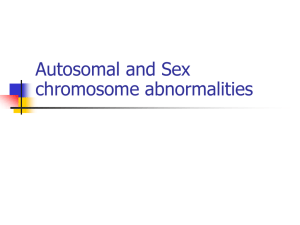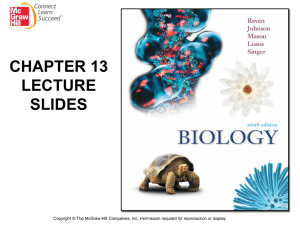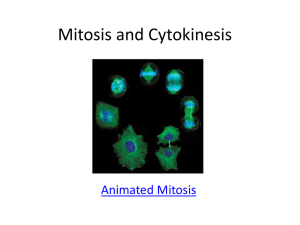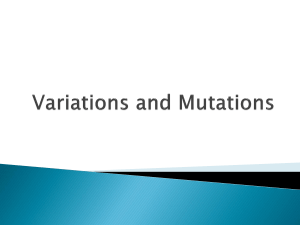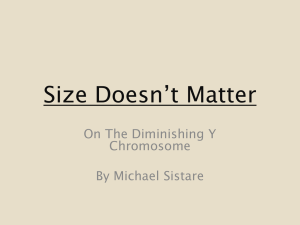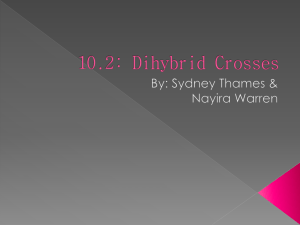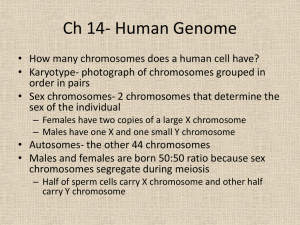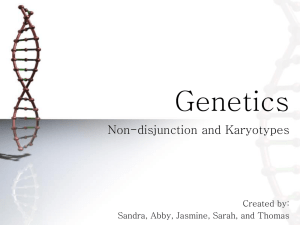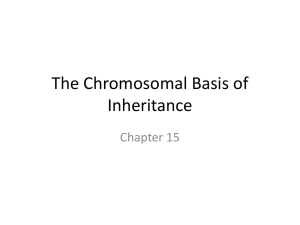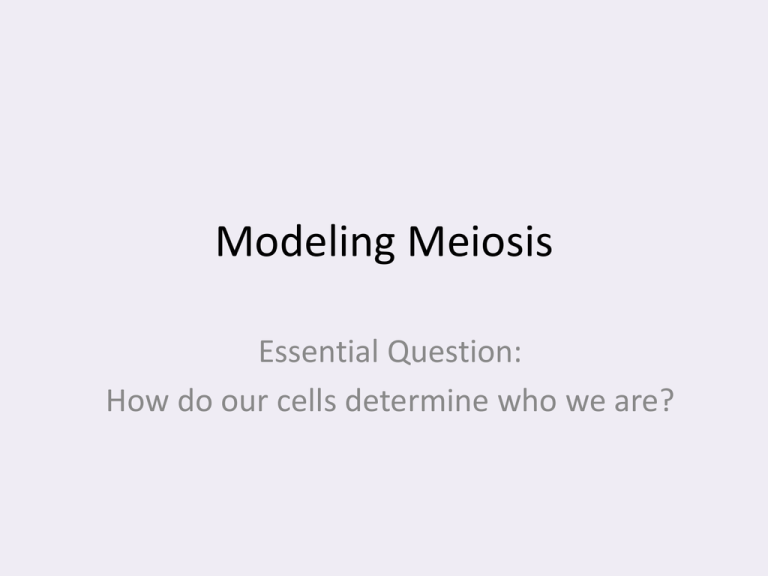
Modeling Meiosis
Essential Question:
How do our cells determine who we are?
Due Monday!
b
Background Information:
Today we are going to do a step by step simulation
of meiosis. We will be working with the
chromosomes of a Puffle, an imaginary organism.
1. If the Puffle has a diploid chromosome number of four, what will the haploid
chromosome number be? __________________
2
2. Place a large paper plate in the center of your work space. Imagine that this is one sex cell
in a Puffle. The boundary of the plate is the cell membrane.
3. You are going to create a diploid nucleus containing two pairs of chromosomes. First,
divide each of your four balls of colored clay in half.
4. Take one-half of each ball and roll it between your hands to form four elongated, snakelike
chromosomes. Make the red and blue chromosomes as long as your index finger. Make the
green and yellow ones half that length. Do the same thing with the other half of clay.
Paper plate
5. Remember that a chromosome is made of tightly coiled strands of DNA. Within
each chromosome there are many, many genes. The chromosomes within each pair
are said to be homologous, meaning similar but not necessarily identical.
Homologous chromosomes contain the same genes but not necessarily the same
alleles. For instance, two homologous chromosomes might contain the gene which
codes for eye color, but the alleles might be different--like blue eye allele on one
chromosome and brown eye allele on the other.
Blue
eye
allele
Brown
eye allele
Homologous
Chromosomes
(1 from mom, other from dad)
6. We are going to examine four traits in the Puffle, specified by four genes. Remember that
genes are segments of chromosomes which code for proteins that cause observable traits
(phenotypes). Table II describes some traits of our imaginary creature and their locations on
each chromosome.
Green Chromosome
Yellow Chromosome
Table II -- Imaginary Traits of the Puffle
Genes on PAIR 1
Fur Color
Fur Type
G (green fur)
c (straight fur)
g (yellow fur)
C (curly fur)
Genes on PAIR 2
Blue Chromosome
Red Chromosome
Eye Color
B (blue eyes)
b (red eyes)
Eyelash length
L (long eyelashes)
l (short eyelashes)
Table II -- Imaginary Traits of the Puffle
Genes on PAIR 1
Fur Color
Fur Type
Green Chromosome
G (green fur) c (straight fur)
g (yellow fur) C (curly fur)
Yellow Chromosome
Genes on PAIR 2
Eye Color
Eyelash length
B (blue eyes) L (long eyelashes)
b (red eyes) l (short eyelashes)
Blue Chromosome
Red Chromosome
g
G
C
c
B
b
L
l
7. Note that we are looking at only two genes on each chromosome, and ignoring hundreds of other
genes. Also, note that the Puffle we are studying is completely heterozygous for all four genes
examined (has both dominant and recessive alleles - Gg, Bb, etc.). This does not always happen.
8. Label the location of each gene by cutting out the paper labels provided and sticking them on to the
clay as shown above. Cut the paper as close to the letters as you can.
INTERPHASE
9. During interphase, each chromosome is replicated by making another complete set of
DNA. Simulate this replication by creating a matching chromosome (same shape and
color) using the extra bits of clay you set aside earlier. Label each chromatid with genes
so they are exact copies.
10. Connect sister chromatids together at the centromere (center point) by pinching
them together as shown below:
g
g
G
G
C
C
c
c
B
B
b
b
L
L
l
l
centromere
8
11. How many chromatids are present at this stage?_________
How many
4
chromosomes? ____________
PROPHASE I
12. Pair up each newly replicated chromosome with its homologous partner, forming two
tetrads (2 pairs of chromosomes, total of 4 chromatids).
13. Now that homologous chromosomes are near each other, crossing-over can occur. In each
tetrad, place one chromatid over another. Then trade alleles so the colors are mixed.
B B
L
b b
l
L
B B
b b
L l
L l
l
g g
GG
g g
GG
C C
c c
C c
C c
METAPHASE I
14. Imagine that the nuclear membrane has now broken down in your imaginary Puffle cell.
Line the two tetrads (pairs of chromosomes) end to end across the center of the cell. Attach
a piece of yarn stretching from the centromere (center point) of each chromosome to the
spindle fibers
end of the cell nearest to it. What do the pieces of yarn represent? ____________________
centromere
Large paper plate
yarn
15. In a real cell, would the red chromosome always line up on the same side as the green
No. Chromosomes line up in random order,
chromosome? Why or why not? _______________________________________________
like shuffling cards.
__________________________________________________________________________
ANAPHASE I
16. Separate each tetrad and use the spindle fibers to move the homologous chromosomes to
opposite poles of the cell as shown below:
TELOPHASE I
17. Cytokinesis (cell division) occurs to form two daughter cells. These daughter cells are
not haploid or diploid, but some kind of intermediate stage. Arrange your clay
chromosome models on two large paper plates as shown below:
GG
g g
BB
Cc
Ll
bb
Cc
Ll
18. Are the two daughter cells identical (in genetic makeup)? Why or why not? ______
No. One chromosome came from mom, other from dad. In
________________________________________________________________________
_________________________________________________________________________
crossing over, they also exchanged parts.
MEIOSIS II
PROPHASE II & METAPHASE II
19. Line up the chromosomes in each cell end to end along the center line. Attach spindle
fibers to the centromeres (center points) as shown below:
centromere
yarn
ANAPHASE II
20. Separate the two sister chromatids and use the spindle fibers to move them to opposite
poles as shown below:
21. In anaphase II, what must happen to the centromere region?
_______________________________________________________________________
Has to break so chromatids can separate
_______________________________________________________________________
TELOPHASE II
22. Cytokinesis occurs again, producing a total of four daughter cells. You can show this by
separating the 8 sets of chromosomes on to 4 small paper plates as shown below:
gCBL
Yellow, curly fur
blue eyes
long lashes
gcBl
Yellow, straight fur
blue eyes
short lashes
GCbL
Green, curly fur
red eyes
long lashes
Gcbl
Green, straight fur
red eyes
short lashes
23. Are these cells haploid? How do you know this? _____________________________
Yes. Each have 1 set of chromosomes, half as many as parent cell
_______________________________________________________________________
different
24. Are the four daughter cells genetically the same as each other or different?_________
different
Are they genetically the same as the parent cells or different? ___________________
Explain why this is so. _______________________________________________________
Chromosomes got mixed up in random order and went to different cells.
_______________________________________________________________________
_______________________________________________________________________
In crossing over, chromosomes traded bits of DNA.
25. Write the genotype and phenotype beneath each of the daughter cells shown in #22.

